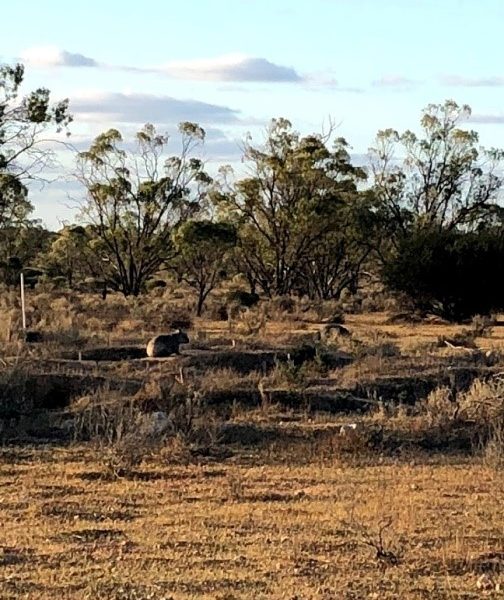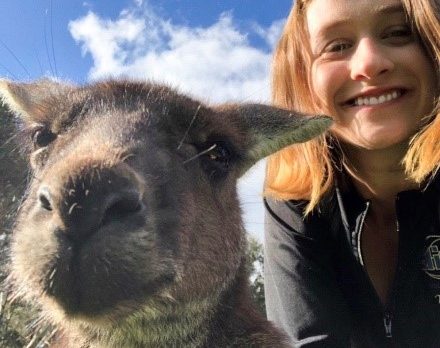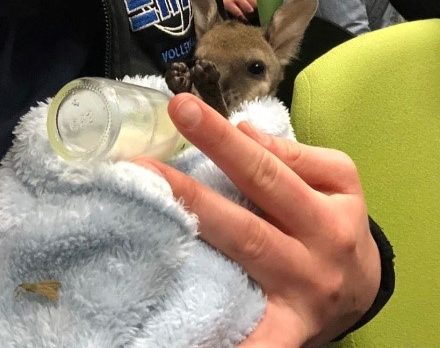
The southern hairy-nosed wombat is a keystone species, South Australia’s faunal emblem, and was listed as Near-Threatened in 2016 (IUCN Red List). Because of this new listing, Dr. Faith Walker, my Primary Investigator (PI) at Northern Arizona University (NAU), renewed her interest in the burrowing marsupial. In 2017, she and a field team headed to Brookfield Conservation Park (BCP) to collect hair samples, the first of many projects she would start that year with wombats. The hair samples were being collected to take a genetic census of the population, which was last done in the early 2000s during Dr. Walkers Ph.D. work. The census will look at how population has declined, if any wombats are still present from the original study, and if space use has changed after 17 years. This project was how I got my start at NAUs Bat Ecology and Genetics Lab, and my introduction to wombats.
As I continue my work on the genetic census, we are also starting another project in our lab: looking at diet, gut microbiome, and pathogens of the southern hairy-nosed wombat. We also wanted to sample kangaroo feces, as the western grey kangaroo (Macropus fuliginosus) is highly abundant and may be impeding wombat population recovery. Wombats are very active in the spring, and Dr. Gaughwin was making plans to take a team into the field to collect these samples for Dr. Walker. As a college student, a trip to Australia was out of my budget, so I began looking for funding to join Dr. Gaughwin’s lab, and found the G2P2Pop RCN lab exchange program.

From September 14th to September 24th I participated in a Laboratory exchange at Brookfield Conservation Park in South Australia. I was hosted by PI Dr. Matthew Gaughwin, and worked with Drs. David Taggert and Bertram Ostendorf, as well as Colin Sobek from NAU. Wombats are more active in spring, making it on opportune time to go into the field and opportunistically collect samples. Having only worked in a laboratory, I was excited to tackle the challenge of field work and an entire new way to conduct research.
During my lab exchange, I was actively involved in the field work activities. Wombats are nocturnal, so each morning we woke up with the sun to begin sampling. We drove to wombat warrens in the 1km2 study site, and sampled fresh feces from around the burrow entrances. We sampled throughout the study site, using GPS to make sure we created a fair representation of the population.
As we drove around, we would also see kangaroos running from the truck. We would wait for the kangaroos to settle down. After a few minutes we would trek out to their resting place to search for fresh feces. When it got hot in the afternoons, we would take a break, going back to camp. Every day the kangaroos would disappear around 11 a.m. and we would not see another one until the sun began setting. While on the hunt for more kangaroo feces in the late afternoon, we would also stop by wombat warrens, as they would come outside to bask in the sun before the cold night came. This was probably my favorite part of the trip, observing the wombats in their natural habitat while they are unaware of us watching. I accidentally stumbled within 20 feet of one, which was awesome because they usually were scared off when anyone on the team got within 50 feet.
We finished sampling all of our feces within the week. It was great to accomplish our goals, especially since the first few days we were very worried about not getting enough kangaroo feces since we were struggling to find fresh samples. With our extra tubes, we collected vegetation from around wombat warrens. The samples of the plants will have their DNA extracted, and we will create a genetic “barcode”, where other scientists can compare their DNA and see if they have the same plant. This will be helpful since there is a lack of information available on Australian flora in most United States databases.

While I was there, a lot of work occurred, but I did get the opportunity to explore Adelaide. The first day we landed, I went to Cleland Wildlife Park, which I recommend to anyone wanting to get a taste of Australian Wildlife. You can pet koalas during certain times of the day, and buy bags of food to hand feed kangaroos and wallaby’s.
Having never seen any marsupials in zoos before, this was a very unique and exciting opportunity for me. I also had the opportunity to meet a wallaby joey named Mikey. His mother was a victim of a hit and run, and he was being cared for by Jo, a woman working at a nonprofit. I was given the honor of bottle feeding him during his afternoon snack.
Camping in the outback was also one of the coolest experiences I have had to date. There were tropical birds flying everywhere, my favorite being the Galah. When walking through the park, I could see Emus running in the distance, and hear magpies and other birds calling to each other. I quickly got over my arachnophobia there, as there were plenty of wolf spiders, huntsman, and orb weavers. I actually came to appreciate the huntsman living on my tent, as he kept down the number of flies and mosquitoes around.

I would recommend applying for a lab exchange to anyone. The contacts and the experience I gained working in the field I made will benefit me for years to come. I would like to thank Dr. Matthew Gaughwin for being an amazing host, as well as Brookfield Conservation Park for allowing us to go into the field and sample this year. I would also like to thank my PI, Dr. Faith Walker, for encouraging me to apply for this lab exchange and the G2P2POP RCN for sponsoring this laboratory exchange.